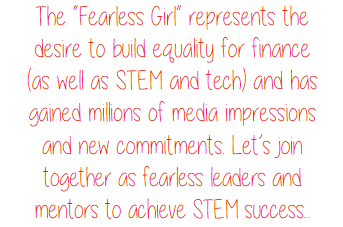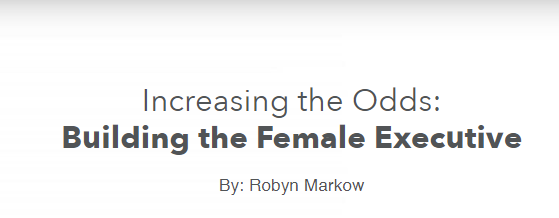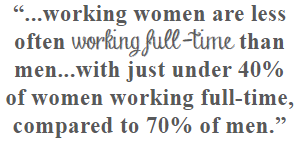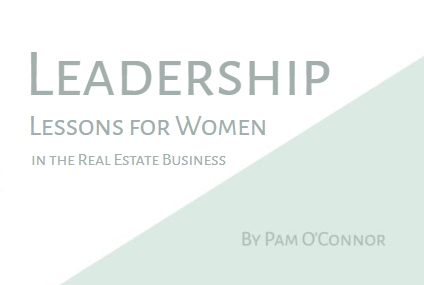STEMconnector® has more than 170 members and has organized to push skills to more than 5 million open jobs. Million Women Mentors (MWM) was established to increase career opportunities for girls and women and has gained nearly 2 million pledges for mentor relationships. The movement has to change the career options for women and girls and reach pay equity by making great jobs and rewarding careers available. STEM jobs provide a means of pay equity; thus, we must provide the economic excitement for women to earn and contribute.
Consider what we are achieving with Million Women Mentors, reaching millions of commitments and bringing the private sector and organizations together to mentor, sponsor and provide internships. Please join us. I had the honor of writing a blog with PepsiCo CEO, Indra Nooyi, back in 2015, which says the following about Million Women Mentors: “We’ve already seen some amazing progress, but imagine what could happen if every STEM professional made a commitment to mentoring one-on-one for just two hours a month. We could truly change the game.”
STEMconnector® is a consortium of companies, associations, academic institutions and government entities actively engaged with STEM education and careers and with the future of human capital. With multiple products and councils, STEMconnector® is both a resource and service, designed to link “all things STEM.”
Gender & diversity is at our core. In the U.S., women and minorities make up the majority of the population and, clearly, the demographics of education. That’s why we launched Million Women Mentors, and we are on our way to 2 million mentor relationships. By endorsing all efforts—from private and public, to educational and organizational— to mentor and change lives, and increase careers in STEM jobs, pay equity is close. Every corporation and institution wants to show their progress and results for gender and diversity based on successful recruitment, engagement and retention.
Commitment to the underserved is part of all that we do, and we are proud of those who do not tolerate inequality and want to focus on making the land of opportunity a reality. STEMconnector® takes pride in “scaling up” what works. Along with the CEO of Tata Consultancy Services, STEMconnector® has committed to Tech Talent for All. It takes great marriages of private and public sectors. The CEO of Sprint, for instance, announced the 1Million Project, which donates tech to those in need. Salute all!
Public policy impact is clear on each of these. If not at the federal level, then we need the support at the local level. Public policy impact must be translated and saluted. Whether we continue support for tech talent for all or CTE Support, we stand up for use of public policy in many ways.
Women’s Equality Day was August 26th, and November is Science and Technology Month. Why can’t we make every day a celebration for gender gains in science and technology and a commitment to improve the numbers? Considering that up to 80 percent of jobs today require tech skills, and all STEM jobs pay women close to parity—about 96 cents on a dollar compared to 80 cents overall—an answer to parity and pay equity will involve technology. Let’s put more effort in gaining STEM skills and especially tech skills, and making tech careers a national priority. We urge all of you to read the McKinsey Global Institute (MGI) report, The Power of Parity: How Advancing Women’s Equality can add $12 Trillion to Global Growth. Gender advancement in STEM and tech is about economic opportunity and equality.

It can’t be the “Old Boys Network” any longer. We know we need a “New Girls Network,” but let’s allow men to be our champions and advocates, and ask CEOs and others to commit to the advancement of women and girls. We can do it together. Don’t accept no. Instead of focusing on “Sexism in Silicon Valley,” let’s build commitments to embracing women in STEM and tech.
Maya Angelou said, “In order to be a mentor, and an effective one, one must care.” We all care about the phones in our hands, the computers on our desks, and the cars that we drive. We must care even more about the girls who want to invent, explore, and discover the next generation of amazing STEM breakthroughs but who just need a little encouragement.
We must move faster. The movie Hidden Figures highlights the roles of three African American female mathematicians working at NASA as human computers. They helped build the space race. There are too few role models for girls today. Women comprise 24 percent in the tech and computer science space, a number that has declined or been static for the past decade; meanwhile, men are jumping ahead. Most high school and university gender numbers are poor, as are the requirements to teach computer science in schools. As NCWIT shares, girls comprise 56 percent of the Advanced Placement (AP) test-takers, yet only 19 percent of the AP Computer Science test-takers. We must advance and encourage all to code and engage in data analytics and other exciting areas. Carnegie Mellon has close to 49 percent women’s enrollment. We are proud to work with many academic institutions pushing the needle, but too few are embracing women in STEM and tech.
Jobs are open in every area of tech, and we must mentor, sponsor, offer great job opportunities and share our successes. We must push to advance women and girls, and role models are vital. Write your own stories and blogs, speak out and act, and, most importantly, execute and report results. Just as we released 100 CEO Leaders in STEM, 100 CIO Leaders, and 100 Diverse Leaders, look for the 2nd edition and release of 100 Women Leaders in STEM in October 2017.
The “Fearless Girl” is a symbol on Wall Street staring down the bronze “Charging Bull.” The “Fearless Girl” represents the desire to build equality for finance (as well as STEM and tech) and has gained millions of media impressions and new commitments. Let’s join together as fearless leaders and mentors to achieve STEM success, and gain more jobs in the tech field, which is dominating finance and every other area. All of us can be catalysts for gender action, and girls and women can—and will—build our economic future, financial achievement and success. Tech underlies all we do. COMMIT to action now as we join together to drive RESULTS.

Thank you, Edie Fraser!

 Login
Login























 Recently, the National Association of REALTORS® (NAR) reported that the highest home buying demand in years is being stifled by tight inventory. In this article, I will demonstrate how you can increase your available inventory by embracing homes in need of renovation.
Recently, the National Association of REALTORS® (NAR) reported that the highest home buying demand in years is being stifled by tight inventory. In this article, I will demonstrate how you can increase your available inventory by embracing homes in need of renovation.




